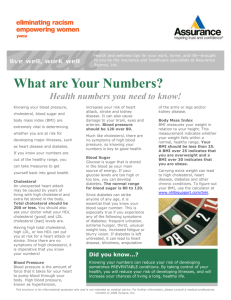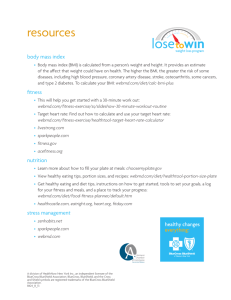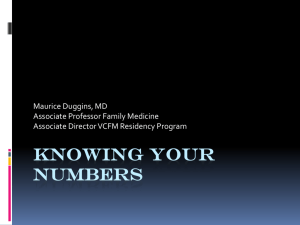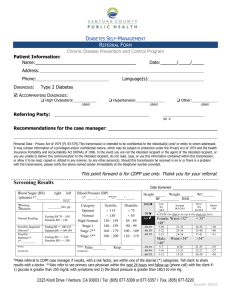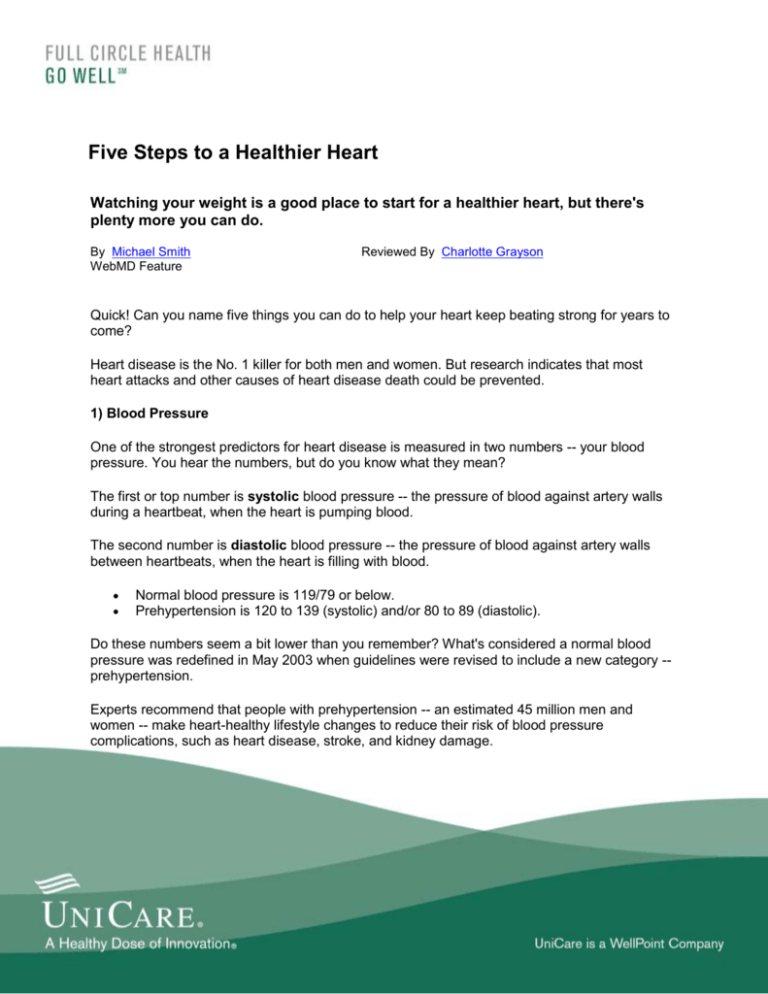
Five Steps to a Healthier Heart
Watching your weight is a good place to start for a healthier heart, but there's
plenty more you can do.
By Michael Smith
WebMD Feature
Reviewed By Charlotte Grayson
Quick! Can you name five things you can do to help your heart keep beating strong for years to
come?
Heart disease is the No. 1 killer for both men and women. But research indicates that most
heart attacks and other causes of heart disease death could be prevented.
1) Blood Pressure
One of the strongest predictors for heart disease is measured in two numbers -- your blood
pressure. You hear the numbers, but do you know what they mean?
The first or top number is systolic blood pressure -- the pressure of blood against artery walls
during a heartbeat, when the heart is pumping blood.
The second number is diastolic blood pressure -- the pressure of blood against artery walls
between heartbeats, when the heart is filling with blood.
Normal blood pressure is 119/79 or below.
Prehypertension is 120 to 139 (systolic) and/or 80 to 89 (diastolic).
Do these numbers seem a bit lower than you remember? What's considered a normal blood
pressure was redefined in May 2003 when guidelines were revised to include a new category -prehypertension.
Experts recommend that people with prehypertension -- an estimated 45 million men and
women -- make heart-healthy lifestyle changes to reduce their risk of blood pressure
complications, such as heart disease, stroke, and kidney damage.
2) Cholesterol
Probably the most familiar heart disease risk factor, cholesterol is a type of fat that is an
essential nutrient for your body. However, too much cholesterol -- or not enough of the good
type of cholesterol -- floating around in your blood increases your risk for hardening of the
arteries that can lead to heart disease, heart attack, and stroke.
Cholesterol is considered abnormal when:
Total cholesterol is 200 or higher.
HDL or "good" cholesterol level is less than 40.
LDL or "bad" cholesterol is more than 160 (or 130 if you have two or more risk
factors) -- with 190 and above being very high. However, the lower the LDL, the
better. An LDL less than 100 is considered optimal; 100 to 129 is near optimal; 130 to
159 is borderline high.
3) Body Mass Index (BMI)
This is an indirect measure of your body fat, a quick way to see if you are overweight. BMI may
be overestimated in people with a lot of muscle mass, such as body builders. It may also be
underestimated in older people who have very little muscle mass.
BMI uses a person's weight and height to gauge total body fat. You can use WebMD's BMI
calculator to determine your BMI.
A BMI of 18.5-24.9 is ideal.
A BMI of 25 to 29.9 is overweight.
A BMI of 30 to 39 indicates obesity.
A BMI of 40 or more indicates morbid obesity, which increases a person's risk of death
from any cause by 50% to 150%, according to The Cleveland Clinic.
4) Blood Sugar
Overweight and too little exercise -- that's what greatly increases the risk of type 2 diabetes. It's
nothing to take lightly because it can lead to heart disease, stroke, kidney disease, and even
blindness.
A fasting blood sugar test -- after not eating or drinking anything but water for at least 12 hours - is most commonly used to diagnose type 2 diabetes.
A normal fasting blood sugar is less than 100.
Prediabetes is a fasting blood sugar of 100 to 125.
A fasting blood sugar of 126 or greater indicates diabetes.
"The bottom line is, take it seriously," Michael Crouch, MD, a family and community medicine
specialist at Baylor College of Medicine in Houston, tells WebMD.
5) Exercise
Yes, you've heard it all before. But we're not talking about an unreasonable commitment here.
The American College of Sports Medicine recommends aerobic exercising three to five days a
week for 30 to 45 minutes. This doesn't mean strapping on the leotards and joining others in the
gym. Exercise that strengthens the heart comes in all shapes and sizes -- biking, swimming,
and jogging, to name a few.
"Walking is perfectly fine," says Crouch. "Anything is better than nothing, but 30 minutes a day
is what we recommend."
With reporting by Jeanie Davis.
Originally published Sept. 3, 2004.
Medically updated Jan. 27, 2005.
SOURCES: Michael Crouch, MD, Baylor College of Medicine, Houston. WebMD Medical Reference from Healthwise.
WebMD Medical Reference provided in collaboration with The Cleveland Clinic: "Body Mass Index (BMI)."
© 2004 WebMD Inc. All rights reserved.
Link to this article:
https://www.webmdhealth.com/common/content/webmdtopic.aspx?webmdlink=/content/news/webmd/arti
cles/102445.htm



